
 News Release November 21, 2025 "DNR keeps walleye limit at three for winter on Mille Lacs Lake"
News Release November 21, 2025 "DNR keeps walleye limit at three for winter on Mille Lacs Lake"
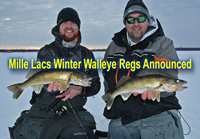 The walleye limit for ice fishing season on Mille Lacs Lake will remain at three fish longer than 17 inches, only one of which can be longer than 20 inches.
The walleye limit for ice fishing season on Mille Lacs Lake will remain at three fish longer than 17 inches, only one of which can be longer than 20 inches.
“Mille Lacs’ walleye population is trending in a good direction for both adult and juvenile fish,” said Brad Parsons, fisheries section manager for the Minnesota Department of Natural Resources. “We’re pleased to keep the current regulation in place for this winter and offer anglers this harvest opportunity.”
For yellow perch, the daily and possession limit will be 10. The change is a shift from last year, which began with a perch daily and possession limit of ..." Read Full Report >> 2026 Mille Lacs Winter Ice Fishing Regulations
 Wired2Fish November 21, 2025 "Which Fish Should You Eat? How to Choose Safe & Sustainable Table Fish"
Wired2Fish November 21, 2025 "Which Fish Should You Eat? How to Choose Safe & Sustainable Table Fish"
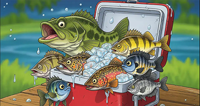 "Catch and release fishing is the cornerstone of modern fisheries’ management. It allows anglers to fish without removing individuals from the population, so that they can reproduce. With careful handling, the population of those fish can hopefully exist in much the same numbers and anglers can continue to catch their favorite species. With any luck, the population might even expand — and some of these fish will grow to large sizes.
"Catch and release fishing is the cornerstone of modern fisheries’ management. It allows anglers to fish without removing individuals from the population, so that they can reproduce. With careful handling, the population of those fish can hopefully exist in much the same numbers and anglers can continue to catch their favorite species. With any luck, the population might even expand — and some of these fish will grow to large sizes.
But that doesn’t mean that you can’t keep a few for dinner. When I was studying for my Wildlife Management degree at the State University of New York at Cobleskill, I was taught that conservation was “the wise use of resources.” While fish are not an infinite resource, it is possible to remove a few without causing the stocks to collapse. Of course, you should be careful about which species you eat, to protect the fish stocks and yourself.
How to Choose Fish For Dinner? When it comes to choosing fish for dinner, you should always ..." Read Full Story and Learn More >> How to Choose Safe & Sustainable Table Fish
More Recent Fishing Reports
Follow on X • Follow on Facebook • Lake of the Woods 11-19 • Lake Winnie 11-13 • Gary Barnard 11-11 • Technology 10-25 • Charts 1-23-25 • MAPS 1-22-23 • Barotrauma Study 1-25-24 • Fish Consumption • Forward Sonar • Panfish Workgroup
 News Release November 2025 "Hook-setting devices allowed starting with the 2025-26 ice fishing season. Hook configuration and length rule also clarified"
News Release November 2025 "Hook-setting devices allowed starting with the 2025-26 ice fishing season. Hook configuration and length rule also clarified"
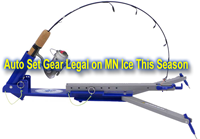 The Minnesota Department of Natural Resources has changed the rule surrounding ice anglers’ use of automatic hook-setting devices and has clarified rules about multiple hook configurations and length. These fishing rule changes will be in effect for the upcoming ice fishing season.
The Minnesota Department of Natural Resources has changed the rule surrounding ice anglers’ use of automatic hook-setting devices and has clarified rules about multiple hook configurations and length. These fishing rule changes will be in effect for the upcoming ice fishing season.
“We want to make sure anglers are aware of these recent rule changes as they enjoy the last days of open water and prepare for ice fishing season,” said John Dunn, DNR’s fisheries rules and regulations coordinator. “Robust public input helped guide our development of these rules, and we are excited to implement them beginning this winter season.”
Automatic hook-setting devices:
Non-motorized devices that set the hook using the force of a ..." Read Story >> Hook-setting devices allowed starting with the 2025-26 ice fishing season
 Lake of the Woods, Rainy River Report November 19, 2025
Lake of the Woods, Rainy River Report November 19, 2025
 "The deer hunting season has taken most anglers off of the water. Rifle shots now ring out periodically around the area, leaving few anglers to take advantage of the great late fall walleye and sauger bite.
"The deer hunting season has taken most anglers off of the water. Rifle shots now ring out periodically around the area, leaving few anglers to take advantage of the great late fall walleye and sauger bite.
Along the south shore of Lake of the Woods, the water temperature has dropped to 40°F. Despite the cold tempertaures, fish are active and biting. The best action remains in 15 to 25 feet of water, and vertical jigging with a frozen emerald shiner or live minnow continues to be the top presentation. Gold, orange, pink and glow colors remain strong.
On the Rainy River, those who fish during the deer hunting season are often rewarded with great action. Again this past week, We've heard about more good reports. Walleye fishing continues to be very good and anglers are catching a nice mix of “eaters” along with some "slot fish", and a few trophies. Jig and minnow remains the go-to presentation, and anglers are focusing on edges that walleyes follow, current breaks, and deeper holes.
Screenshots from some of the resort webcams show ice showing up in boat harbors and back bays along the lake. As of 11-18-2025, some thin ice is appearing on parts of the the river as well. On average, ice fishing kicks off around December 10, though Mother Nature will ultimately decide when it’s time. Resort guides and outfitters who work the ice daily will monitor conditions closely and let everyone know when the ice they’re on is ready.
Up at the Northwest Angle, some back bays and marinas with ice this past week. All part of the progression as there is a bit of late fall fishing going on, but most are looking forward to ice fishing. For those getting on the water still, good numbers of walleyes are being caught on both sides of the border. Location of the fish is setting up nicely for ice fishing. It won't be long!" — Lake of the Woods Tourism, (800) 382-FISH
 November 13, 2025 Sundin: "My First PanOptix"
November 13, 2025 Sundin: "My First PanOptix"
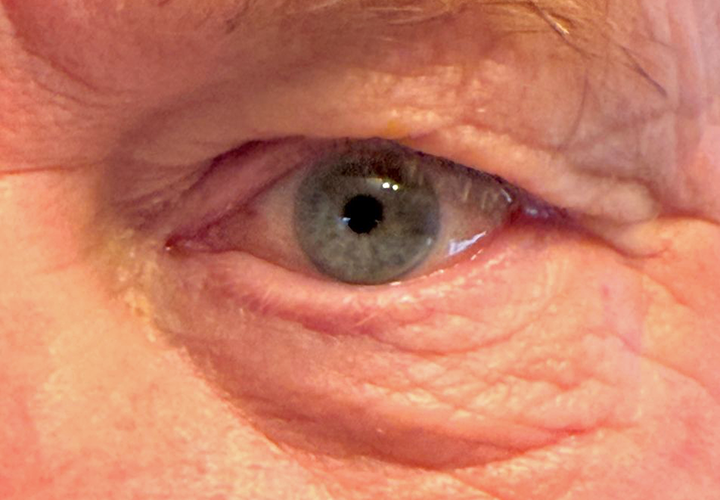 "I can hardly wait for my next chance to go fishing. I got my first “Panoptix” yesterday, and I’m anxious to see if it helps me catch more fish!
"I can hardly wait for my next chance to go fishing. I got my first “Panoptix” yesterday, and I’m anxious to see if it helps me catch more fish!
You didn’t jump to any conclusions did you? You weren’t thinking that I bought some new electronics for my boat did you? No, that’s not what happened yesterday at all. Instead, I got my first cataract removed, and a new tri-focal lens replacement implanted in my left eye. “PanOptix”, the type of multifocal intraocular lens used in the procedure, gave I and Susan a chuckle when we saw it in the pre-op information packet.
All joking aside, the procedure went well, and this morning, I can already notice the clarity of my vision improving. Before long, the first lens should settle in, and then I’ll have the other eye done too. So, with luck, I can soon throw away my multiple pairs of reading glasses and surveil various fish habitats with renewed enthusiasm.
Before any of that happens, I hope to find time to pursue a deer. The firearms deer season opener last weekend went well for everybody in my hunting party except me; they all bagged at least one deer. Mother Nature, apparently knowing that I wouldn’t have time to take proper care of harvested deer, opted not to send one in my direction. Now, I’m looking forward to “seeing” one during the muzzle loader season later this month.
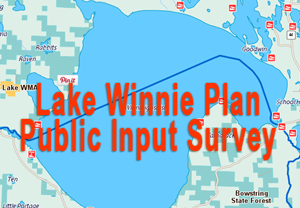 Checking my emails this morning, I found a few notes from readers, which I’ll share with you soon. Also in my inbox, a note from Brett Nelson, Area Fisheries Supervisor for the Minnesota DNR in Grand Rapids. The note, shared with members of the Lake Winnie Workgroup says, “Good evening WINFIG members! Just wanted to follow up with you and let you know the online scoping survey is now out so please spread the word.”
Checking my emails this morning, I found a few notes from readers, which I’ll share with you soon. Also in my inbox, a note from Brett Nelson, Area Fisheries Supervisor for the Minnesota DNR in Grand Rapids. The note, shared with members of the Lake Winnie Workgroup says, “Good evening WINFIG members! Just wanted to follow up with you and let you know the online scoping survey is now out so please spread the word.”
You may recall, I already shared an MN DNR press release about the Lake Winnie survey back on November 10, 2025. So, if you have already completed the questionnaire, thank you!
If you missed the original notice, the survey aimed at gauging public opinions and preferences will be used in the development of a formal management plan for Lake Winnibigoshish (including Cut Foot, Little Cut Foot, and Sugar Lakes). When finalized, this plan will guide fisheries management on Lake Winnibigoshish from 2027- 2037.
The survey is your chance to inform the MN DNR about how you utilize the natural resources from Lake Winnibigoshish. The questions on the survey focus on your priorities for future management. I took the survey myself, and it took about 10 minutes to complete.
The survey, aimed at gauging public sentiment about fishing situations specific to Lake Winnibigoshish can be found here, on the "Engage with DNR" web page. The survey is avaible right now, and will run to December 12, 2025. So, if you or somenone you know fishes Winnie, or has an interest in it, I encourage you to click right now and take advantage of the chance to influence the system."
![]() — Jeff Sundin, The Early Bird Fishing Guide Office Cell Call or Text 218-245-9858 or Email on Facebook on X
— Jeff Sundin, The Early Bird Fishing Guide Office Cell Call or Text 218-245-9858 or Email on Facebook on X
 Rainy River Report L.O.W. Tourism, November 12, 2025
Rainy River Report L.O.W. Tourism, November 12, 2025
 "Not many remain fishing this time of year as Minnesota's traditional firearms deer hunting season is in progress. Those who fish during the deer hunting season are often rewarded and there are a few anglers fishing the Rainy River. Walleye fishing right now is good, and anglers are catching a mix of “eaters” along with some fish in the protected 19.5 to 28 inch slot sizes. Occasionallly, there's a bonus "pig", tropy walleye over 28 inches also being caught.
"Not many remain fishing this time of year as Minnesota's traditional firearms deer hunting season is in progress. Those who fish during the deer hunting season are often rewarded and there are a few anglers fishing the Rainy River. Walleye fishing right now is good, and anglers are catching a mix of “eaters” along with some fish in the protected 19.5 to 28 inch slot sizes. Occasionallly, there's a bonus "pig", tropy walleye over 28 inches also being caught.
A jig and minnow remains the go-to bait presentation. Walleye structures that anglers are focusing on include edges that walleyes follow, current breaks, and deeper holes.
On the south end of Lake of the Woods, there is still a strong late-fall walleye and sauger bite going on. Fish continue to be staged in various areas along the south shore and they are biting.
The water temperature has dropped to 42°F and the fish are active. The best action remains in 15 to 25 feet of water.
Vertical jigging with a frozen emerald shiner or live minnow continues to be the top presentation. Gold, orange, pink and glow colors remain strong.
Up at the Northwest Angle, some back bays have frozen up with a skim of ice this past week, so most folks are looking forward to ice fishing.. Once again, those few anglers who are pursuing walleyes or muskies are being rewarded with great results. Big numbers of walleyes are being caught on both sides of the border.
On average, ice fishing kicks off around December 10, though Mother Nature will ultimately decide when the time is right. Resort guides and outfitters who work the ice daily will monitor conditions closely and let everyone know when the ice they’re on is ready. Location of the fish is setting up nicely for ice fishing. It won't be long!" — Lake of the Woods Tourism, (800) 382-FISH
 Wired2Fish November 12, 2025 "Is It Possible To Use Forward-Facing Sonar Without Selling Your Soul?"
Wired2Fish November 12, 2025 "Is It Possible To Use Forward-Facing Sonar Without Selling Your Soul?"
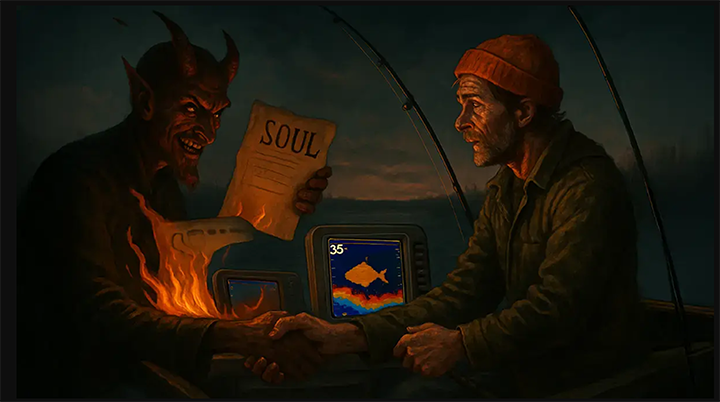 "Is it possible to use forward-facing sonar without selling your soul? Perhaps that’s a little bit of a goading way to put it, but that is in essence the question I have been asking myself these last couple of years. The vast majority of anglers have dug their heels in on this topic, one way or the other. They either want to use it all the time with no restrictions, or they want the tech in its entirety banned from tournaments and made illegal.
"Is it possible to use forward-facing sonar without selling your soul? Perhaps that’s a little bit of a goading way to put it, but that is in essence the question I have been asking myself these last couple of years. The vast majority of anglers have dug their heels in on this topic, one way or the other. They either want to use it all the time with no restrictions, or they want the tech in its entirety banned from tournaments and made illegal.
But I find myself still riding the fence. Is there a place to land in the middle? Is that too much to ask in the partisan and polarizing modern world? Here’s what I think.
My History With FFS: I have just enough experience with FFS to be dangerous with it. I don’t currently have a FFS system on my boat, but I actually had a Garmin unit with Panoptix (the company’s early LIVE imaging) on it for a ..." Learn More >> Is It Possible To Use Forward-Facing Sonar Without Selling Your Soul?
 November 11, 2025 PODCAST "Rare Breed" Gary Barnard Talks Walleyes, Northern Pike, Technology and More
November 11, 2025 PODCAST "Rare Breed" Gary Barnard Talks Walleyes, Northern Pike, Technology and More
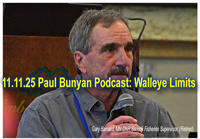 "To say that Minnesota anglers are passionate about the outdoors is an understatement. Angler sentiment drives countless hours of discussion about everything from minnows to muskies. Gather a dozen anglers, ask a single question, and you’re liable to get 13 opinions.
"To say that Minnesota anglers are passionate about the outdoors is an understatement. Angler sentiment drives countless hours of discussion about everything from minnows to muskies. Gather a dozen anglers, ask a single question, and you’re liable to get 13 opinions.
Many outdoor enthusiasts don’t think much about it, but that passion for the outdoors is not unique to anglers and hunters. That same enthusiasm for the outdoors, hunting, fishing and more, is what drives people to join Minnesota’s Department of Natural Resources too. Like us, folks hoping to enjoy the same great fishing and hunting as everybody else are also the people most attracted to jobs within the various divisions of the DNR.
Gary Barnard, one of those passionate outdoorsmen did just that. Joining the Minnesota DNR Fisheries Division as a technician in the mid-1970s, Barnard worked up the ranks, becoming the Bemidji Area Fisheries Supervisor in about 1994. Now retired, Barnard’s passion for the outdoors continues, and is equaled only by his knowledge of it. I've been a fan for a long time, and after today, I think you will be too.
Recently, KBUN Sports Radio’s Paul Bunyan Country Outdoors Podcast featured Barnard. In it, he discusses a lot, but walleyes, walleye fishing and walleye limits gets a lot of attention. I think the interview is one of the best I’ve heard, and I learned a lot. Barnard’s ability to break down complex issues and make them understandable makes this podcast, I believe, “required listening” for all Minnesota anglers. Follow this link and enjoy one of the more thorough and thoughtful podcasts you’re ever going to hear." >> KBUN Paul Bunyan Country Outdoors Podcast "Rare Breed: Gary Barnard"
 News Release November 2025 "DNR invites public input to update of Lake Winnibigoshish management plan November 10, 2025"
News Release November 2025 "DNR invites public input to update of Lake Winnibigoshish management plan November 10, 2025"
 "The Minnesota Department of Natural Resources invites people interested in Lake Winnibigoshish to share their thoughts on prioritizing future management of the lake, as an initial step in updating the lake’s management plan.
"The Minnesota Department of Natural Resources invites people interested in Lake Winnibigoshish to share their thoughts on prioritizing future management of the lake, as an initial step in updating the lake’s management plan.
The Lake Winnibigoshish management plan (including Cut Foot, Little Cut Foot and Sugar lakes) is set to be updated over the next two years.
The updated master plan will consider current public values and attitudes about the lake and will be used to guide management of Lake Winnibigoshish fish populations and habitats. It will include management goals, objectives and strategies for the lake for..." Learn More >> November 11, 20225 Lake Winnibigoshish Management Public Comments
 November 5, 2025 "Wrapping the Wrap-Able" Thanks, I Needed That! Fishing Season Ending Wrap Up
November 5, 2025 "Wrapping the Wrap-Able" Thanks, I Needed That! Fishing Season Ending Wrap Up
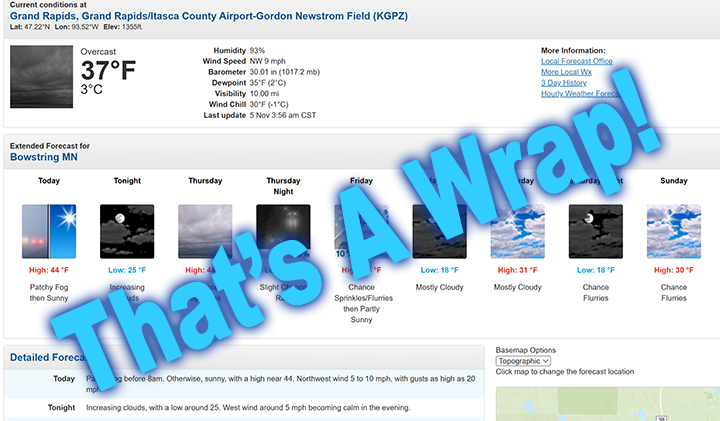 I don’t expect many will recall the 1970s TV commercials for Mennen Skin Bracer. The ones where John Goodman, after slapping the popular after shave on his face smiles and says, “Thanks, I Needed That”.
I don’t expect many will recall the 1970s TV commercials for Mennen Skin Bracer. The ones where John Goodman, after slapping the popular after shave on his face smiles and says, “Thanks, I Needed That”.
Mother Nature just gave me my own “thanks I needed that” moment. I walked outside, discovered ice on the top of my minnow tank, and a frozen hose nozzle. So, I went back to my computer, logged into the weather forecast and read the sad news. Overnight lows in the 20s and daytime highs barely touching 30 are on the tap for the next several days.
That means the suspense is over and the end of my open water season has arrived. The signal to get the boat dried out, covered up and put away for winter has been received. Today. We’ll get the outside chores done and make ready for the long winter ahead.
Did you know that 2025 marked the end of my 40th season as a full-time, professional fishing guide? Yes, that’s right, and if you count a few years of part time guiding in the Twin Cities before that, we could stretch it to say 43 years. No matter how we count those part time years, next spring will officially mark the start of my 5th decade earning my living holding a tiller handle in one hand, and a fishing rod in the other.
This morning, I want to take a moment to say thank you to everyone who not only helped make this a great fishing season, but also for what has been a fabulous fishing career. Customers, readers, friends and fans alike, I couldn’t be here without you, and I can’t begin to thank each of you enough for your support.
The open water season may be over, but as always, I’ll be around. I’ll continue filling you in about the countdown to ice fishing, answering reader questions and bringing you updates about whatever timely fishing news that comes our way. That said, I’ll be moving at a slower pace for a little while and maybe issuing reports a little bit later in the mornings. So, if you want to be sure not to miss any fresh reports, please be sure that you’re signed up for the free insider newsletter. That way, you’ll be notified whenever there’s a timely update.
![]() — Jeff Sundin, The Early Bird Fishing Guide Office Cell Call or Text 218-245-9858 or Email on Facebook on X
— Jeff Sundin, The Early Bird Fishing Guide Office Cell Call or Text 218-245-9858 or Email on Facebook on X
 Lake of the Woods, LOW Tourism, November 5, 2025
Lake of the Woods, LOW Tourism, November 5, 2025
 "Good numbers of walleyes have moved into the Rainy River and fishing has been strong. Anglers are catching a nice mix of “eaters” along with slot fish (19.5 to 28.0 inches). A jig and minnow remains the go-to bait choice, and anglers are focusing on current breaks, deeper holes, and river bends.
"Good numbers of walleyes have moved into the Rainy River and fishing has been strong. Anglers are catching a nice mix of “eaters” along with slot fish (19.5 to 28.0 inches). A jig and minnow remains the go-to bait choice, and anglers are focusing on current breaks, deeper holes, and river bends.
As tradition goes, the deer hunting season timeframe often produces some of the biggest walleyes of the year — while some folks are in a tree, others are on the river catching trophies!
A strong late-fall walleye and sauger bite continues across the south shore of Lake of the Woods. Fish are staged and hungry, setting up beautifully for the start of the upcoming ice fishing season. The water temperature has dropped to 45°F, and fish are actively feeding as they transition into winter patterns. The fall fishing is consistent and action-packed, expect a nice mixed bag of walleyes, saugers, perch, and occasional pike.
The best action remains in 15 to 25 feet of water along traditional fall locations. Check out shoreline flats from Pine Island to Morris Point Gap, Zippel Bay, Long Point, and over to Twin Islands.
Vertical jigging with a frozen or live minnow continues to be the top presentation. Gold, orange, and glow colors remain productive, with combinations of gold/orange and pink doing especially well. Some anglers are still covering water by trolling crankbaits, but most agree the jig bite is unbeatable right now.
The stage is set for what looks to be another excellent early ice season! On average, ice fishing kicks off around December 10, though Mother Nature will ultimately decide when it’s time. Resort guides and outfitters who work the ice daily will monitor conditions closely and let everyone know when the ice they’re on is ready to fish.
Up at the Northwest Angle, once again, fishing is excellent. Walleyes are stacked up on points, reefs, and mud-to-rock transitions, and when you find them, it’s game on. A simple jig and minnow is all you need for steady action on both walleyes and saugers, along with perch, crappies, and pike.
Anglers are reporting strong numbers of fish across both the U.S. and Canadian sides of the islands. Resorts and guides continue to offer lodging, late-fall open-water trips, and upcoming ice fishing packages as the season shifts." — Lake of the Woods Tourism, (800) 382-FISH
 Reader Comments November 4, 2025 "Angler Ethics; Are They Ethical?"
Reader Comments November 4, 2025 "Angler Ethics; Are They Ethical?"
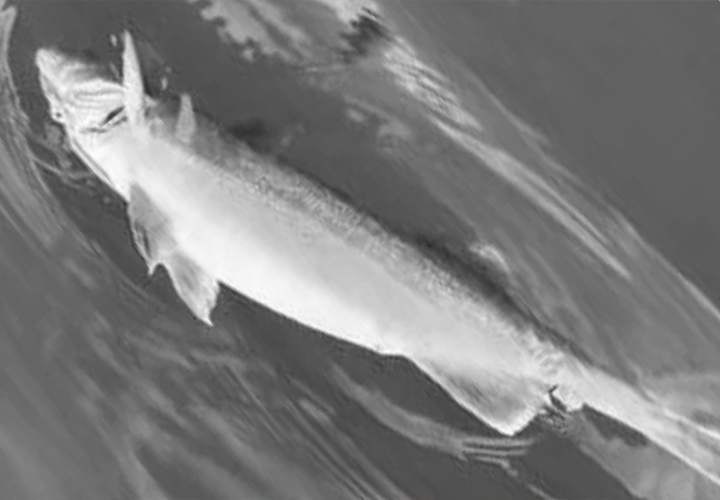 Reader and frequent commentator Rand Olson wrote; "Jeff, appreciated your article (October 27, 2025 "Catch and Release, or Catch and Kill? Pros and Cons of Forward-Facing Sonar"), and your interest in it. The subjects of catch and release, Forward Facing Sonar, (FFS) and barotrauma are all interesting to read and discuss. But (these topics) almost impossible to make any final conclusions or regulation changes because there are so many variables at play.
Reader and frequent commentator Rand Olson wrote; "Jeff, appreciated your article (October 27, 2025 "Catch and Release, or Catch and Kill? Pros and Cons of Forward-Facing Sonar"), and your interest in it. The subjects of catch and release, Forward Facing Sonar, (FFS) and barotrauma are all interesting to read and discuss. But (these topics) almost impossible to make any final conclusions or regulation changes because there are so many variables at play.
Here is my personal input.
Catch and Release: I, like you have seen the images of floating dead walleyes which brings a moment of sadness when viewing. However, I can’t say I see this every time I go out on the water, and I will say I am seeing it less and less. So, my question, is this problem as big as we think it is? You are a guide who is on the water most every day and may come to a better conclusion than my brief experience and I would certainly yield to your position.
FFS: My comment here is simply, not every owner of FFS is as proficient with this technology as the young run and gunners (who are) out sharpshooting. I too have Live scope but I am far from a young sharpshooter. Because of my age 71 and fully aware of my limitations (balance in the boat, rough water, etc.) I use it to simply confirm whether there are or there are not fish in the area I want to target. Is it helping me catch more fish? I think so, but I’ll never be even close to the proficiency pf the sharpshooters who are really good with it. And I’ll bet good money fisherman like me make up around 60% of FFS ownership.
Barotrauma: Thankfully, most of the lakes I fish don’t get this deep, but I am fully aware of both the depth, water temperature and the time out of water when releasing fish.
 Education: Because the subjects above are almost impossible to legislate. Education must be the key to future stewardship. Here is how education has changed my views of the sport of walleye fishing.
Education: Because the subjects above are almost impossible to legislate. Education must be the key to future stewardship. Here is how education has changed my views of the sport of walleye fishing.
Limits of fish: I like everyone else loves catching a limit of fish as all men feel more manly, when we accomplish this goal. However, I have vowed that I will only catch what I can eat fresh. So, when my take home limit is gone, so too are my (supply of) fillets, no fillets ever go to the freezer.
Fishing mortality: Nothing disgusts me more than seeing a walleye that is gut hooked from using a live bait rig. Especially disgusting is when, on occasion, it is I who did it. Therefore, I have vowed to change my fishing practice when using live bait rigs. Now, I present them only with a closed bail, as if I am jig fishing. If I lose them because of not feeding out line, then I lose them but I can retain the satisfaction of not inadvertently killing a walleye.
Hopefully, the info above is somewhat helpful, maybe its simply more bloviating but I write it because you care so much about the proper and best way forward to this most satisfying pastime. Enjoy your thinking time in the deer stand. Sincerely, Rand"
Out of Sight, Out of Mind.
 REPLY: "Rand, thank you for taking the time to share your thoughts. Your commentary covers a lot of territory, and all the topics are worthy of lengthy responses. I’ll do my best to break them down, offer my best reply, but also leave open the opportunity for additional commentary going forward.
REPLY: "Rand, thank you for taking the time to share your thoughts. Your commentary covers a lot of territory, and all the topics are worthy of lengthy responses. I’ll do my best to break them down, offer my best reply, but also leave open the opportunity for additional commentary going forward.
First, your question about catch and releasing mortality is an important one in many ways. You mention not seeing a lot of dead fish floating on the surface near your favorite fishing spots. You go on to ask, is this problem as big as we think it is? The only honest answer is “we don’t know”, at least not for sure.
 Dead fish, of any species, rarely wind up floating on the surface. Most often, fish that are hooked and released by anglers do not die immenditately. When they do die, they're much more likely to wind up on the bottom, rather than floating on the surface. Fish that do eventually wind up floating on top of the water often drift to shore where they are seldom observed by the masses. So, counting on visually observing dead fish floating on a lake isn't likely to be an accurate way of judging hooking mortality.
Dead fish, of any species, rarely wind up floating on the surface. Most often, fish that are hooked and released by anglers do not die immenditately. When they do die, they're much more likely to wind up on the bottom, rather than floating on the surface. Fish that do eventually wind up floating on top of the water often drift to shore where they are seldom observed by the masses. So, counting on visually observing dead fish floating on a lake isn't likely to be an accurate way of judging hooking mortality.
We do know that anglers, even those with the best of intentions, kill a certain number of fish as they release them. Some of the release mortality is caused by improper handling, some of it by barotrauma, and still more of it is caused simply by the stress of fish being caught and handled. Angler harvest, a more easily identified form of fish mortality must also be considered, and natural mortality is a big part of the equation too.
Provided there are fish available to catch, most anglers don’t seem concerned by fish mortality. So, one could ask the question in a different way. When you add up fish mortality in all its forms, are there still enough fish remaining in each lake to produce a new crop that will mature in time to provide angler opportunity going forward? If so, then maybe the discussion is finished.
Already revealed in your comments, fish mortality has been with us for a long time. Deeply hooked with live bait rigs, warm water stress, and inadequate training in effective handling techniques are not new problems. Despite those challenges, there have generally been enough fish to go around and satisfy most of the angler demand. So, we can only assume that until now, fish mortality has not been a large enough problem to over-burden fish populations.
 So, What’s The New Problem?
So, What’s The New Problem?
Brought about by the availability of forward-facing sonar, is an angler’s ability to effectively target fish at any time of the year and in open water habitat. Not only does FFS allow us target fish in open water, often deep-water habitat, but now, skilled anglers can even target specific, individual fish. So, instead of anglers “fishing for whatever bites”, some anglers can now seek out and catch only the exact fish they choose. This concerns folks who see “sharpshooters” targeting fish in deep water or singling out only the largest fish in a system.
Studies on the subject are in short supply, and the ones that have been completed are informal, providing only rudimentary information. Still, there is some information emerging. In a recent meeting of the MN DNR Technology Workgroup, Mike Knapp, Brainerd Area Fisheries Supervisor revealed results of a study.
The study, a joint project between MN DNR Fisheries, Central Lakes College and the Walleye Alliance investigated the number of anglers using FFS. Three Brainerd area lakes, Gull, Edward and Lower South Long were targeted and creel survey clerks asked anglers specific questions about their use of FFS. For me, there were 3 takeaways from the results of the surveys.
- Angler use of FFS is on the rise, more anglers are adopting the technology
- Angler effectiveness using FFS is on the rise as anglers move higher on the learning curve
- Release of fish mortality is an increasingly important consideration, targeting large fish
As the accompanying summary reveals, 70% of the anglers targeting walleye on Gull Lake were using FFS. Those 70% of walleye anglers accounted for catching 83% of the walleyes reported in the survey.
Walleyes in Gull Lake are primarily stocked fish, so releasing large females doesn’t necessarily help the cause of future year classes. That said, released fish, provided they survive, can provide opportunity for anglers to go forward. I guess that means mortality isn’t the most pressing issue on Gull, but what about other lakes?
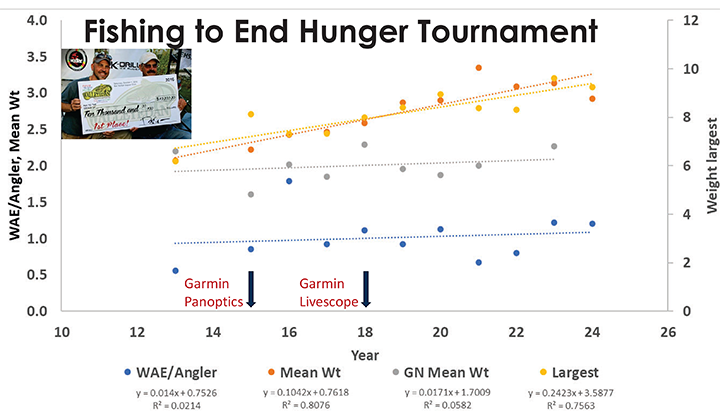 After the tech meeting, I returned home and began searching YouTube videos produced by anglers who were targeting walleyes in open water. I thought some of them offered sound advice and demonstrated responsible use of technology. There were others, though, that really disturbed me. Images of high level, prominent anglers who were giddy with happiness as they yanked monster walleyes out of deep, 30 to 35 feet of water. Yes, they released those fish, and yes, the fish did appear to swim away and yes, if they all survive, then maybe all is well.
After the tech meeting, I returned home and began searching YouTube videos produced by anglers who were targeting walleyes in open water. I thought some of them offered sound advice and demonstrated responsible use of technology. There were others, though, that really disturbed me. Images of high level, prominent anglers who were giddy with happiness as they yanked monster walleyes out of deep, 30 to 35 feet of water. Yes, they released those fish, and yes, the fish did appear to swim away and yes, if they all survive, then maybe all is well.
But wait, we already know for a fact that some of those fish will die. And we know too that there are protected slot limits aimed at keeping those fish alive, albeit temporarily. So, my question is why is it okay to intentionally pursue, catch, and kill, even unintentionally, any fish, including a walleye that would otherwise be protected?
If the DNR Fisheries Scientists tell me that targeting and catching big walleyes, or any other fish in deep water is okay, then fine, I’m going to start doing it too. But how can anybody answer that question without first learning more about walleye survival and its impact on fish populations under these circumstances?
While there are some general studies about hooking mortality on walleyes, none that we know of have been directly related to the use of FFS technology, or barotrauma injury to fish caught in deep water.
Finally, this is where your point about education comes into play Rand. You’re absolutely correct that we cannot legislate how technologies are used, or the impacts they will have on fish in specific circumstances. But even without knowing the precise scientific ramifications of catching fish in every situation, like targeting fish in deep water, we can still make good judgements about the generally accepted “best practices” for targeting and releasing fish.
Low Expectations = Low Results!
I see nothing wrong with educating our fellow anglers about doing their best to provide future generations with quality fishing opportunities. I see nothing wrong with using peer pressure to influence their behavior either. We should strive, I think, to raise our standards about being more protective of fish and game populations in Minnesota.
Some folks tell me that it won’t work. They say that the only way to protect resources is to change rules and pass laws. In their view, restricting access to opportunity is better than encouraging folks to access opportunities, but manage them to provide the most positive outcomes possible.
What’s the difference? Most game and fish laws are rarely enforced, and their influence on anglers depends on public acceptance anyway. So, in my view, everything boils down to the honor system anyway. And when it comes to honor, you either have it, or you don’t. ![]() — Jeff Sundin, The Early Bird Fishing Guide Office Cell Call or Text 218-245-9858 or Email on Facebook on X
— Jeff Sundin, The Early Bird Fishing Guide Office Cell Call or Text 218-245-9858 or Email on Facebook on X
Fish Recipes Sundin: "Bluegills Sautéed with Dill Sauce" (Click Images To Enlarge)
 Ask hall of fame fishing guide Jeff Sundin what his favorite fish is to catch and without doubt, the reply will be Sunfish. Widely sought nationwide, sunfish, bluegills, pumpkinseeds, sun perch or bream, whatever you call them, are widely available and a blast to catch. Let’s not forget, these scrappy fish are not only fun to pursue, but they are delicious to eat too!
Ask hall of fame fishing guide Jeff Sundin what his favorite fish is to catch and without doubt, the reply will be Sunfish. Widely sought nationwide, sunfish, bluegills, pumpkinseeds, sun perch or bream, whatever you call them, are widely available and a blast to catch. Let’s not forget, these scrappy fish are not only fun to pursue, but they are delicious to eat too!
Here's a delicious recipe for preparing sunfish that is both easy and fast. Endorsed by longtime Minnesota fishing guide Jeff Sundin, this dish, sautéed bluegills in dill sauce will surely be a big hit on your fishing vacation, or at your next family gathering.
Ingredients for sautéed bluegills are readily available and ..." Learn More >> November 2, 2025 Recipe For Bluegills Sautéed in Dill Sauce
You Are Invited To Become A Duly Deputized Fishrapper Cub Reporter Too!
 If you've been waiting for a gold engraved invitation to participate in the daily reports, then stop waiting and consider this your own personal invitation.
If you've been waiting for a gold engraved invitation to participate in the daily reports, then stop waiting and consider this your own personal invitation.
Helping your fellow fishermen and women stay abreast of fishing conditions in your area is good for everybody and it's easier than you think! You don't have to write a book, you don't have to share your secret fishing spots and you don't even have to mention your lake. You see, with just a few words about general trends, seasonal patterns or local weather conditions you can help steer your fellow anglers to more gratifying fishing experiences. So, be like Dan and Sean, and become a duly deputized "Cub Reporter", it's good for fishing and that's good for everybody!
Use the Contact Us page, or if you prefer to be "social", use our community page on facebook Fishing Reports Minnesota, that is the Facebook counterpart to this page and it is open to the public, so you can post your own fishing update or just share a photo of a nice catch.